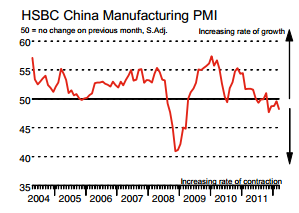Euro Dollar
USD – U.S. Federal Reserve Beige Book, the Fed’s official assessment on economic conditions in the 12 Federal Reserve districts.
Released exactly two weeks before the Fed’s next monetary policy meeting on April 24-25, the Beige Book report should confirm the signs of consistent improvement in the U.S. economy, lessening the likelihood of more quantitative easing by the U.S. central bank. As long as QE3 odds remain low, the USD should benefit.
The dollar index, which tracks the performance of the dollar against a basket of other major currencies, rose to 79.923, versus a level of 79.840 seen in late North American trading on Friday.
Euro is weak, but trading within its three day range; support at 1.3035 looks vulnerable. With holidays across Europe, there has been limited news flow. However, Japan and China have announced that they will hold official talks leading into the G20 (April 19/20) on the potential for addition IMF funding.
China’s inflation edged up in March as the government shifted focus from containing politically dangerous price rises to stimulating its slowing economy.
The euro is trading at 1.3064
The Sterling Pound and the Swiss Franc
EURCHF is trading at 1.20182. The Swissie has strengthened 0.2% v. the euro, following the re‐ lease of stronger than expected inflation and downward pressure on EURUSD. EURCHF fell briefly below the SNB’s floor at 1.2000, the first such occurrence since the floor was imposed in September of 2011. Our expectations are for the EURCHF floor to be raised in the coming months, following the selection and approval of a new SNB president.
Swiss and UK markets were closed on Friday and Monday for the Easter holidays. They should open today and respond to the weakness in the USD
Asian –Pacific Currency
JPY- Bank of Japan Interest Rate Announcement,
The recent efforts of the Bank of Japan to weaken its currency have been successful and it would not be surprising to see policy makers considering additional quantitative easing as a tool to curb the yen strength, to create inflationary pressures and to stimulate the economy. It is not very likely that the benchmark rate will be changed from the current target band between 0% and 0.10%, but we might even hear some officials calling for a 2% inflation target, which could trigger another leg lower for the yen.
AUD- Australia Employment Report and Unemployment Rate, the main measures of labor market conditions. After losing 15,400 jobs in February, the Australian economy is forecast to add up to 7,000 new jobs in March, but the unemployment rate is expected to increase to 5.3% from 5.2% in the previous month. A disappointing jobs report could see pressures rising on the Australian dollar.
Against the yen, the dollar fell ¥81.30 against a North American trading level of ¥81.55 on Friday. The move into the yen, often viewed as a safe-haven currency, came after nonfarm payroll data released Friday showed a smaller-than-expected rise in March payrolls, of 120,000. Economists had expected a gain of 210,000.
The AUD/USD was trading at 103.40 US cents, up from 103.05 cents on Thursday, before the Easter public holiday. The Australian dollar has moved higher, as US markets weakened in response to unimpressive jobs figures. China posted an unexpected trade surplus of $5.35 billion in March, after reporting a deficit of $31.48 billion in February. Exports rose 8.9% in March from a year earlier. And imports rose 5.3%, compared with economists’ forecast for a 9.3% rise.
Gold
Gold traded higher Monday, catching some safe-haven flows after a soft U.S. jobs report Friday, which also stirred expectations for new rounds of policy easing. Gold rose $15.50, or 1%, at $1,645.70 per ounce on the Comex. Gold gained 1% on Thursday.
Crude Oil
Crude Oil tumbled sharply on Monday, hit by a disappointing report on U.S. employment late last week and ahead of international talks over Iran’s nuclear program. The multination summit is set for April 13, 2012. Investors remain concerned with the high inventory and lowered demand. Crude-oil fell $1.90, or 1.8%, to $101.41 a barrel in the New York Mercantile Exchange.
The market reopened Monday after being closed for the Good Friday holiday. On Thursday, oil rose $1.84, or 1.8%, to settle at $103.31.



